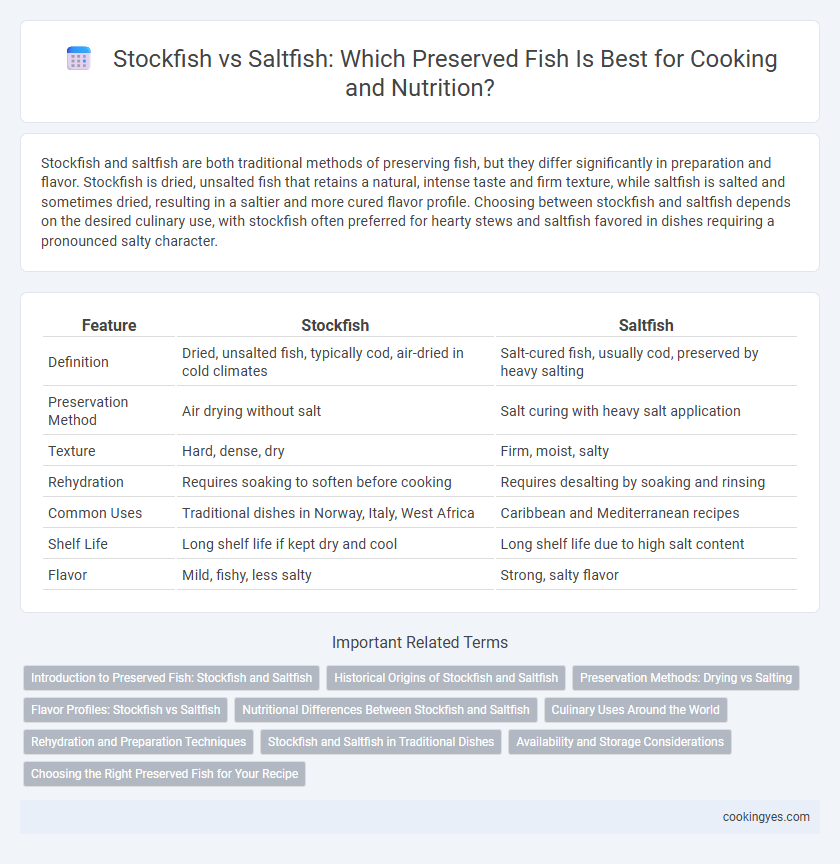Stockfish and saltfish are both traditional methods of preserving fish, but they differ significantly in preparation and flavor. Stockfish is dried, unsalted fish that retains a natural, intense taste and firm texture, while saltfish is salted and sometimes dried, resulting in a saltier and more cured flavor profile. Choosing between stockfish and saltfish depends on the desired culinary use, with stockfish often preferred for hearty stews and saltfish favored in dishes requiring a pronounced salty character.
Table of Comparison
| Feature | Stockfish | Saltfish |
|---|---|---|
| Definition | Dried, unsalted fish, typically cod, air-dried in cold climates | Salt-cured fish, usually cod, preserved by heavy salting |
| Preservation Method | Air drying without salt | Salt curing with heavy salt application |
| Texture | Hard, dense, dry | Firm, moist, salty |
| Rehydration | Requires soaking to soften before cooking | Requires desalting by soaking and rinsing |
| Common Uses | Traditional dishes in Norway, Italy, West Africa | Caribbean and Mediterranean recipes |
| Shelf Life | Long shelf life if kept dry and cool | Long shelf life due to high salt content |
| Flavor | Mild, fishy, less salty | Strong, salty flavor |
Introduction to Preserved Fish: Stockfish and Saltfish
Stockfish and saltfish are traditional methods of fish preservation essential for long-term storage and transport without refrigeration. Stockfish is air-dried unsalted fish, primarily cod, which retains its natural flavor and texture through cold biomass dehydration. Saltfish, commonly made from cod as well, undergoes salting and drying, enhancing shelf life and imparting a distinctive salty taste ideal for culinary uses in Caribbean, Scandinavian, and Mediterranean cuisines.
Historical Origins of Stockfish and Saltfish
Stockfish, dried without salt primarily in Norway, dates back to the Viking Age when air-drying methods preserved cod for long sea voyages and trade. Saltfish, originating from the Mediterranean and Atlantic regions, involves curing fish with salt to extend shelf life during the Age of Exploration in the 15th century. Both preservation techniques developed independently but became vital commodities in global trade, influencing dietary habits across Europe and the Americas.
Preservation Methods: Drying vs Salting
Stockfish is preserved primarily through air drying, a method that removes moisture to inhibit bacterial growth while maintaining the fish's natural flavor and texture. Saltfish undergoes salting, where fish is cured in salt to draw out water and prevent spoilage, resulting in a denser, saltier product. Both techniques extend shelf life but impact the fish's taste, texture, and rehydration requirements differently, making them suited for distinct culinary uses.
Flavor Profiles: Stockfish vs Saltfish
Stockfish offers a mild, slightly sweet flavor with a firm and chewy texture, making it ideal for dishes that require a subtle fish taste. Saltfish, heavily salted and cured, delivers a pronounced salty and umami-rich profile that intensifies after soaking and rehydration. The choice between stockfish and saltfish affects the overall seasoning and flavor depth in traditional preserved fish recipes.
Nutritional Differences Between Stockfish and Saltfish
Stockfish retains higher levels of protein and essential vitamins like vitamin B12 due to its natural drying process without added salt, while saltfish contains elevated sodium levels from the salting method, which can impact cardiovascular health if consumed excessively. The preservation technique of saltfish often reduces certain water-soluble nutrients but enhances shelf life significantly, whereas stockfish maintains more of its original nutrient profile, including omega-3 fatty acids. Consumers seeking lower sodium intake should prefer stockfish, although both provide substantial amounts of calcium and minerals vital for bone health.
Culinary Uses Around the World
Stockfish, air-dried cod predominantly used in Scandinavian and West African cuisines, offers a dense texture ideal for stews and soups like Nigeria's famous egusi soup and Norway's traditional lutefisk. Saltfish, salt-cured and dried, is essential in Caribbean and Portuguese dishes, providing a strong, savory flavor in recipes such as Jamaican ackee and saltfish and Portugal's bacalhau a bras. Both preservation methods extend shelf life while creating distinct flavors that are integral to regional culinary identities globally.
Rehydration and Preparation Techniques
Stockfish requires prolonged soaking and rehydration in cold water over several days to restore its texture and flavor before cooking. Saltfish, heavily salted and dried, typically demands rinsing and boiling to reduce salt content and rehydrate fibers efficiently. Proper preparation techniques for both preserved fish types ensure optimal taste and texture in traditional culinary dishes.
Stockfish and Saltfish in Traditional Dishes
Stockfish, an unsalted dried cod, is celebrated for its firm texture and rich umami flavor, making it essential in traditional Nordic and African dishes like Norwegian lutefisk and West African soups. Saltfish, typically salted and dried, offers a saltier taste and is a staple in Caribbean and Portuguese cuisines, used in dishes such as Jamaican ackee and saltfish or Portuguese bacalhau. Both preservation methods extend shelf life and infuse unique flavors, highlighting regional culinary traditions.
Availability and Storage Considerations
Stockfish is widely available in Northern European markets, prized for its shelf-stability without refrigeration due to natural air-drying, whereas saltfish is more common in Caribbean and West African regions, preserved through heavy salting which requires careful rehydration before use. Stockfish storage involves cool, dry environments to maintain quality over months, while saltfish demands airtight containers to prevent moisture absorption and spoilage. Understanding these regional availability and storage differences is essential for culinary applications and long-term preservation.
Choosing the Right Preserved Fish for Your Recipe
Stockfish, air-dried without salt, retains a firm texture and mild flavor ideal for recipes requiring rehydration and subtle taste, such as traditional Scandinavian stews. Saltfish, heavily salted and dried, offers a stronger, saltier profile perfect for dishes needing bold seasoning like Caribbean saltfish and ackee. Selecting between stockfish and saltfish depends on your recipe's salt tolerance and desired texture, with stockfish favored for gentle flavors and saltfish for intensified seasoning.
Stockfish vs saltfish for preserved fish Infographic

 cookingyes.com
cookingyes.com